Poetry captures our senses. Poems can make readers laugh, ponder, and imagine.
Even though National Poetry Month is in April, we encourage teachers to infuse poetry on a daily basis throughout the year. There are multiple benefits to sharing the richness of a poets’ inventive language, imagery, and rhymes with students of all ages. Poetry can spark a child’s creativity and launch a delightful exchange of words and images. It can also help us to understand our world, ourselves, and others. Poetry can be musical, insightful, pleasurable, and enlightening.
Poetry fits naturally into a child’s innate inquisitiveness for language and amusement. It also supports interdisciplinary classroom connections. There are outstanding selections of poetry to read aloud and celebrate for every subject: math, reading, science, art, music, social studies, and more! As teachers develop text sets for their classroom library, they will want to find some outstanding poetry. Many outstanding interactive classroom resources can be found on ReadWriteThink.org’s National Poetry Month page.
In this column, we highlight recently published poetry for grades K-12 that we hope you will read aloud to your students and integrate across your curriculum. We also include a review of a professional resource and share several digital tools.
Enjoy, imagine, and celebrate the power of language! Happy Poetry Month!
Grades K-3
Graham, Joan. (2014). The poem that will not end: Fun with poetic forms and voices. Illus. by Kyrsten Brooker. Las Vegas, NV: Two Lions.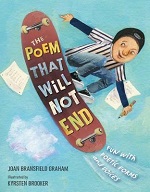
The melodious rhythm and beat of poetry magnetically attracts the inner creativity of a young boy, Ryan O’Brian. He tries to go about his day as usual, but he is struck by the playfulness of language and experiments with different voices and poetic forms. On his way to school, he captures his excitement by writing a poem on his friend’s shirt. He tries to escape the circuitous rhyme, but not even his jazzy skateboard can “leave a trail of …rhyme” (14) behind. There are various examples of different poetic forms woven throughout this clever book perfect for budding writers.
-Mary Napoli, Penn State Harrisburg
Janeczko, Paul. (2014). Firefly July: A year of very short poems. Illus. by Melissa Sweet. Somerville, MA: Candlewick Press.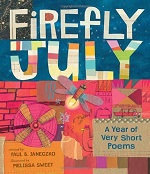
An exquisite collection of carefully selected poems graces the beautifully designed pages of this charming anthology. The poems are arranged by seasons, with a detailed table of contents for easy reference. Each poem echoes the universality and images of the season. For example, Raymond Souster’s “Spring” will remind readers of nature’s gentle beauty: "Rain beats down / roots stretch up. / They'll meet / in a flower" (6). Overall, the short poems in this anthology capture the simplicity and splendor of the senses that will, when read aloud, captivate and excite readers. Melissa Sweet’s expressive illustrations add to the overall impact and sense of wonder in this must-have anthology for classroom libraries.
-Mary Napoli, Penn State Harrisburg
Oliver, Lin. (2014). Little poems for tiny ears. Illus. by Tomie dePaola. New York, NY: Nancy Paulsen Books.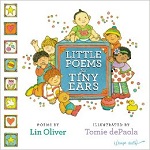
From first glance, this book has the look and feel of a classic lullaby collection. The very words of the title conjure connections to other beloved first books, such as Ten Little Fingers and Ten Little Toes (Fox, 2008) and Counting Kisses (Katz, 2001). The twenty-three poems in this collection are devoted to the familiar and commonplace in a baby or toddler’s world: the car seat, blankie, and body parts (toes, nose). The simplicity of the concepts behind these poems matches perfectly with the characteristically charming art of dePaola. The artist uses thick borders to create frames for each scene. These boxes are stylized with corner embellishments and coordinating colors. This consistent format creates a warmth and intimacy within the book.
The children portrayed feature a range of skin tones and ethnic features such that children will see themselves reflected on these pages. Children and parents are invited to celebrate daily life through these playful first-person poems. The child’s perspective is captured in authentic descriptions of daddy’s beard (“it scratches when you rub it”), bath time (“rubber duckies, floating books/suds and bubbles, happy looks”) and dogs (“I wonder why they have wet noses”). As an added feature, the book’s jacket is designed as wrapping paper with a page of stickers included as well.
-Lesley Colabucci, Millersville University
Wheeler, L. (2013). The pet project: Cute and cuddly vicious verses. Illus. by Zachariah Ohora. NY: Antheneum.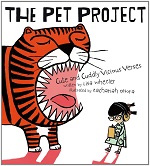
Before turning the first page, readers are warned, “animals aren’t always charming,” thus setting the tone for this clever and interactive story in rhyme. The book functions on several levels as the narrator gathers data regarding “the best pet for me.” Portions of the text are located in her notebook where she documents her investigation and other elements of the scientific process (test subject, controlled environment, and naturalistic observation) appear throughout the book.
The heart of the book features poems about each animal she considers as a pet. Some pets are described briefly, “chances of getting a hippo: zippo.” Others, such as gerbils and bunnies are explored in more depth and the art adds to the descriptions, extending the humor and further showcasing the narrator’s observational skills. She worries her goldfish will overeat and the fish blows up to take over its bowl. She observes a snake and decides “never mind” after seeing it being fed. In the end, the narrator bemoans “inconclusive investigations” and “disappointments.” She ends the book without a pe,t but that anticlimax will send readers right back to the beginning of the book to hear about peeing guinea pigs, dogs in backpacks, and pooping cows all over again.
-Lesley Colabucci, Millersville University
Grades 4-5
Florian, D. (2014). Poem depot: Aisles of smiles. NY: Dial Books.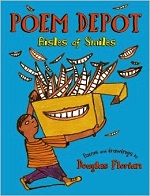
Many teachers rely on poetry anthologies to help incorporate poetry into the regular routine of their classrooms. In this collection, Florian departs from his thinner, more topical collections (Poetrees, 2010; Handspring, 2005) to offer a book dedicated to humor. The chapters are organized by types of jokes (tons of puns), kinds of laughs (hee-haws and great gaffaw), and forms of humor (willy-nilly sillies). The poems range in length and style, from simple rhyming verse about being buried in snow to longer poems about the power of a love potion. Readers will find plenty of examples of repetition and alliteration as well as a variety of forms including some shape poems and variations on diamante and haiku.
Each poem is accompanied by a drawing, mostly characterized by thick lines done in pen-and-ink. Some of the sketch-like renderings are funny enough to get their own laughs while others require the interplay with the poem itself. For instance, a nose with feet and a carrot with a face will serve as motivation to read the poem and discover the connection. The book also features two very helpful indices, one of titles and one of first lines.
-Lesley Colabucci, Millersville University
Lewis, J. Patrick & Florian, Douglas. (2014). Poem-mobiles: Crazy car poems. Illus. by Jeremy Holmes. New York, NY: Schwartz & Wade Books.
The imaginative spirit of collaboration comes to life in this clever collection of free-verse poems. Readers will delight in listening to the clever word play about inventive modes of transportation, from an eel-ectric car to a dragonwagon. Imagine taking a ride in the supersonic ionic car, “the fastest land vehicle running by far” (35). The futuristic and lively illustrations add to the overall effect of these creative poems. It’s an excellent collection to read aloud and integrate during a unit about inventions. These fanciful modes of transportation will certainly ignite students’ creative writing.
-Mary Napoli, Penn State Harrisburg
Prelutsky, J. (2012). Stardines: Swim high across the sky and other poems. Illus. by Carin Berger. NY: Greenwillow Books.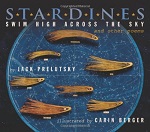
In this book, the art and poems are inextricably tied. Prelutsky’s imaginary creatures come to life both through his words and through Berger’s 3D-style renderings of the imagined creatures. The artist created miniature dioramas using a variety of materials from cut paper to found objects. These unique assemblages are then displayed in a framed encasement, or sit free floating on the page. The results are life-like such that you feel like you could reach in and touch the items. For the magpipes, who have a “tendency to drone/their voices are a nasal/cacophonic monotone,” the picture shows two birds with horns attached blowing out sheet music in ribbons. The curling scraps of paper sneak outside of the frame and jump off the page.
The creativity of this collection is uniquely matched to the orderliness imbued in the illustrations. Careful page layout and formatting holds the collection together. Each page is numbered and each creature warrants its own double-paged spread. The “specimens” are tagged and labeled with proper spelling and pronunciation guides. This ingenious collection invites readers to experiment with the wordplay and engage in their own novel forms of imaginative investigations.
-Lesley Colabucci, Millersville University
VanHecke, Susan. (2014). Under the freedom tree. Illus. by London Ladd. Watertown, MA: Charlesbridge. 
This powerful book is based on true events that occurred during the Civil War near the Emancipation Oak, a historic tree that still stands in Hampton, Virginia. Told in staccato verse, VanHecke elucidates an important part of Civil War history. In 1861, three slaves, Frank, James, and Shepard, decided to escape by boat from Confederate Virginia to find freedom. They were soon joined by others and built a community known as “Slabtown” where they worked for the Union army and built two camps. At the center of the town, missionaries would teach slave children to read under a tall oak tree.
The last page illustrates a young boy surrounded by community members gathered beneath the mighty oak reciting Lincoln’s Emancipation Proclamation. The back matter includes further historical insights about these true events.
-Mary Napoli, Penn State Harrisburg
Grades 6-8
Grimes, N. (2013). Word with wings. Honesdale, PA: Wordsong.
This book is reminiscent of others that feature young writers finding thing way and sorting out their troubles through the written word. Grimes’ main character in Word with Wings is similar to her high school writers in Bronx Masquerade (2002) and also to such characters as Jack from Love that Dog (Creech, 2001) and Lonnie from Locomotion (Woodson, 2003). Gabby is struggling with her parent’s divorce and adjusting to a new school. Additionally, she has trouble controlling her tendency to daydream.
Grimes’ poems allow readers to join Gabby in her daydream world while also experiencing the real-life story. The poems are mostly free verse with some variations on haiku. Some feature the use of shape and plenty offer figurative language: “I swallow words like honey/smile at their sweetness/ and say, ‘Yes!”/my favorite word/of all.” The book is short at only eighty-three pages. Its power lies in getting to know Gabby and meeting a teacher who finds a way to harness her creativity. Ultimately, this book is an homage to dreamers, to words, and to teachers.
-Lesley Colabucci, Millersville University
Nagai, Mariko. (2014). Dust of Eden. Chicago, IL: Albert Whitman & Company.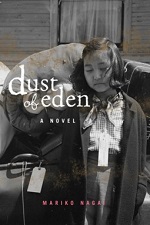
This poignant novel in verse sheds new light about life at U.S. Japanese-American internment camps. Poet, Mariko Nagai, introduces readers to thirteen-year-old Mina Masako Taga. Through first person poems and letters from Mina to several family members, readers will learn about the heartbreaking injustices of being forced to live at the internment camp.
When news about the bombing of Pearl Harbor is announced, Mina internally grapples with her feelings and confusion about her identity: “I’m not Japanese, I want to yell. I’m an American, I scream in my head, but my mouth is stuffed with rocks; my body is a stone, like the statue of a little Buddha Grandpa prays to…” In August 1942, Mina and her family are forced to leave their house and sent to the Minidoka Relocation Center. The poetry, compelling and thoughtful, will help readers to better understand the displacement, indignities, and struggles faced by Mina and her family members. This accessible and important historic novel provides a glimpse into the past—ideal for the social studies and language arts classroom.
-Mary Napoli, Penn State Harrisburg
Grades 9-12
Hopkins, Lee Bennett. (2013). All the world’s a stage. Illus. by Guy Billout. Mankato, MN: Creative Editions.
This is an ideal partner text for any introduction to Shakespeare’s “All the World’s a Stage” soliloquy. Anthologist Lee Bennett Hopkins ambitiously finds contemporary poetic voices to capture the essence of human existence as echoed in Shakespeare’s monologue.
In the classroom, teachers can invite students to discuss whether the stages are relevant to the lives of men and women today. They can create individual or group digital poetry anthologies. Students would self-select poems of personal significance and meaning. Using digital platforms (i.e. Glogster, Padlet, iMovie), students can add images, sound, and video to enhance their interpretation and response.
-Mary Napoli, Penn State Harrisburg
Sones, S. (2013). To be perfectly honest: A novel based on an untrue story. NY: Simon & Schuster.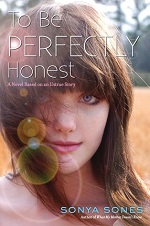
Readers familiar with Sones’ previous novels in verse will not be disappointed with this newest endeavor. As in One of those Hideous Books Where the Mother Dies (2004) and What my Girlfriend doesn’t Know (2007), the author presents realistic fiction in prose-style free verse on topics of interest to young adult readers. In this case, the story goes beyond the typical concerns of dating and family dynamics to questions of honesty and infamy. This book features the reappearance of Colette from One of those Hideous Books Where the Mother Dies. Fifteen-year old Colette and her brother Will are visiting their mom on the set of a movie for the summer. Readers learn immediately of Colette’s prowess as a liar and this unreliable narrator will keep them guessing throughout this fast-paced novel.
The four hundred and eighty page volume can seem overwhelming, but the poems are each one to two pages long and feature quick transitions. The heart of the story surrounds a budding romance between Colette and Connor. As this love affair develops, readers realize that Colette may not be the only skilled liar in the relationship. Colette has to face the depth of her own deceitfulness as she realizes the damage of lies and secrecy that she has both caused and endured. To be Perfectly Honest has the feel of romance with a fair bit of mystery mixed in.
-Lesley Colabucci, Millersville University
Alexander, K. (2014). The crossover: A basketball novel. Boston: Houghton Mifflin Harcourt.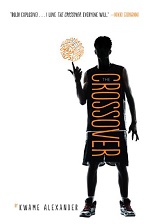
Josh Bell and his twin brother, Jordan (JB) are star basketball players. Their mom is the principal at their school. Their parents have been fighting and their father is struggling with unemployment and an unspoken medical condition. This novel in verse is told from the perspective of Josh, who may be losing his brother to a love interest and losing ground on the court (he loses a bet, has to cut off his dreadlocks, and he gets suspended from the team).
Many sports-based books miss the mark on literary quality or lack wide appeal; Alexander avoids those pitfalls with this heartfelt story in verse that features free verse and hip-hop style poems. Many of the poems lend themselves to oral performance, especially several that capture dialogue (ideal for two voices) and the vocabulary poems which explore definitions in depth. Perhaps the best poems feature the on-the-court action. The Crossover is a unique multicultural offering because of its portrayal of an African-American middle class family with a focus on the tween years.
-Lesley Colabucci, Millersville University
Professional Resource:
Vardell, Sylvia & Wong, Janet. (2014). The Poetry Friday Anthology for Science: Poems for the School Year (K-5). Princeton, NJ: Pomelo Books.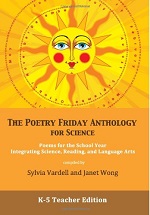
This impressive anthology of over 200 original, unpublished poems for grades K-5 celebrates the creative collaboration and work of over 75 popular children’s poets. The list of featured poets includes J. Patrick Lewis, Marilyn Singer, Rebecca Kai Dotlich, X.J. Kennedy, Douglas Florian, Carmen T. Bernier-Grand, Amy Ludwig VanDerwater, Janet Wong, Margarita Engle, and many more.
As a way to celebrate poetry and bring the ingenious idea of the Poetry Friday blog into the classroom, Vardell and Wong have again provided an outstanding resource for classroom teachers. Similar in format to the Poetry Friday Anthology Common Core edition for K-5 and 6-8 respectively, their latest volume focuses on poetry to connect science, reading, and language arts. This resource provides excellent background information about the educational values and benefits of linking poetry and science. It features an informative rationale, tips for reading poetry aloud, and interdisciplinary teaching suggestions.
The featured poems can be woven across the literacy and science curriculum to address state and national standards. As teachers implement the Next Generation Science Standards (NGSS) and find ways to promote literacy across content areas, this anthology will serve as an invaluable tool to meet their students’ diverse needs and interests. In addition to the teacher’s edition, the editors compiled corresponding grade level student editions for classroom use.
Dr. Vardell, Janet Wong, and several outstanding children’s poets will present a symposium entitled, How is a Poet Like a Scientist? Maximizing Teachable Moments in Both Reading and Science at IRA14 on Sunday, May 11, 2014 from 11:00 a.m. to 1:00 p.m.
There will be a number of poetry related sessions at the International Reading Association Conference, including
The Poetry Olio on Saturday, May 10, 2014 from 7:30 – 9:30 p.m. with America’s Children’s Poet Laureate, Kenn Nesbitt, and many other featured poets. Check out other sessions at the
conference website.
-Mary Napoli, Penn State Harrisburg
Poetry Related Blogs, Resources, and Awards:
Poetry for Children
Poetry Tag Time
Lee Bennett Hopkins Award
IRA Lee Bennett Hopkins Promising Poet Award
Poetry Foundation: Children’s Poet Laureate
No Water River
These reviews and resources are submitted by members of the International Reading Association’s Children’s Literature and Special Interest Group (CL/R SIG) and are published weekly on Reading Today Online.
CL/R SIG will host a special session entitled Children's Literature: The Perfect Teachable Moment on Saturday, May 10 at 3:00 p.m. at the International Reading Association 59th Annual Conference in New Orleans. The session celebrates award-winning children's and young adult books and authors. Author Nancy Bo Flood is the keynote session speaker. Her work encompasses more than a dozen books. Her recent historical fiction "Warriors in the Crossfire" is set in Saipan during WWII, and was selected on the 2011 Notable Books for a Global Society (NBGS) list. The NBGS list represents selections and authors from all genres K-12, with a focus on understanding of and appreciation for the world's full range of diverse cultures, ethnic, and racial groups. The session will also include presentation of the 2014 Notable Books for a Global Society (NBGS) list by members of the selection committee. Visit http://www.iraconference.org to learn more about IRA 2014 or to register.